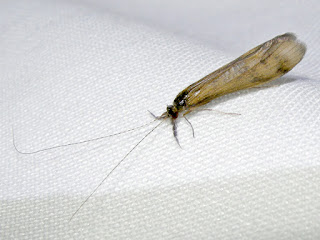Family SERICOSTOMATIDAE
Welshman's Button Sericostoma personatum - A female netted along the footpath west from Carsaig on Mull on 10th June 2019 was my first ever, but swiftly followed by another female closer to home at the meadows on 22nd August. Then in 2020 I caught not one but 3 in my garden moth trap between 1st August and 3rd September. These included 2 males with their distinctive enlarged palps.
female Welshman's Button Sericostoma personatum, between Carsaig and Rubha Dubh (Mull), 10th June 2019
female Welshman's Button Sericostoma personatum, North Elmham Cathedral Meadows, 22nd August 2019
male Welshman's Button Sericostoma personatum, North Elmham, 1st August 2020
male Welshman's Button Sericostoma personatum, North Elmham, 14th August 2020
Notidobia ciliaris - None - there are quite a few widespread records in Norfolk so maybe some chance of finding one here sooner or later.
-----------------------------------
Family BERAEIDAE
Beraea maurus - None. Another caddisfly that is widespread in Norfolk but which I haven't found yet.
Beraea pullata - I finally found my first representative of this family on 24th April 2020 when I swept one from Broom (adjacent to a dyke) at the meadows. That's not the way I usually find caddisflies and it was right next to where I often do mothing with lights so maybe this family is reluctant to come to light?
female Beraea maurus, North Elmham, Cathedral Meadows, 24th April 2020
Beraeodes minutus - None. Judging from the number of dots on the NBN Atlas this looks like it's the commonest member of the family in Norfolk, but it's escaped my detection so far.
-----------------------------------
Family MOLANNIDAE
Molanna angustata - 3 in the garden moth trap between 7th and 26th August 2019 and 9 in the 6 nights between 9th and 14th August 2020. Elsewhere 2 more August records from the meadows (one each year), one at Hills and Holes on 21st May 2020 and one at Bintree Woods on 24th July 2020.
male Molanna angustata, North Elmham, 7th August 2019
male Molanna angustata, North Elmham, 10th August 2019
Molanna angustata, North Elmham Cathedral Meadows, 22nd August 2019
Molanna angustata, North Elmham Cathedral Meadows, 7th August 2020
-----------------------------------
Family LEPTOCERIDAE
Adicella reducta - None. Apparently another common and widespread caddis that I haven't encountered yet.
Triaenodes bicolor - One in my garden moth trap on 22nd July 2019 was my first record of this species. It was on its last legs but that did mean it posed with its wings spread providing a good look at the difference in the colour between its fore and hindwings.
Triaenodes bicolor, North Elmham, 22nd July 2019
Ylodes conspersus - None but I've had one here before in August 2017 which I gather was the first for the Wensum Valley. A pretty scarce species in Norfolk with just 2-3 records from the Nar Valley and one from the Norwich area I believe.
Athripsodes albifrons - Singles in the garden trap on 28th August 2019 and 9th and 14th August 2020.
female Athripsodes albifrons, North Elmham, 28th August 2019
Athripsodes albifrons, North Elmham, 14th August 2020
Athripsodes bilineatus - One at the meadows on 22nd August 2019 was my first record of this species.
female Athripsodes bilineatus, North Elmham Cathedral Meadows, 22nd August 2019
Athripsodes cinereus - 2 at the meadows on 7th July and 22nd August 2019, my first records of this species, and then I added it to the garden list with one on 23rd August. There were 2 more at the meadows in 2020, on 7th August and 8th September. All but one of these were female.
female Athripsodes cinereus, North Elmham Cathedral Meadows, 7th July 2019
male Athripsodes cinereus, North Elmham Cathedral Meadows, 22nd August 2019
female Athripsodes cinereus, North Elmham Cathedral Meadows, 7th August 2020
female Athripsodes cinereus, North Elmham Cathedral Meadows, 8th September 2020
Another eventual candidate for this species was at home on 22nd June 2020. Females are quite challenging for me, and up until 2020 the task was made easier by being able to compare genitalia with the images on the trichoptera.insects-online.de website. With this site now down I'm pretty much relying entirely on the Barnard and Ross Handbook and this particular individual was tricky. In many respects the genitalia looked very similar to
Athripsodes aterrimus (one of which I was examining at the same time). The indentation on the edge was perhaps closer to
cinereus but the subgenital plate looked identical to the
aterrimus, right down to the triangular wedge between where the two halves diverge at the tip. But I don't think it can be
aterrimus because that species always seems to have a slightly arched sub-rectangular sclerite beyond the tip of the subgenital plate (not sure what this bit is called but you can see it on the photo of aterrimus at the bottom of this page), whereas on this caddisfly there was no sign of this - instead a more square-shaped but with an obvious indentation on the top. Unless someone more experienced gets back to me in the meantime I shall wait until I can catch more
cinereus to compare with this before I record this one.
possible female Athripsodes cinereus, North Elmham, 22nd June 2020
Athripsodes aterrimus - The 2019 season started with singles at the meadows on 25th May and 15th June but then I caught 4 in the garden between 24th June and 3rd August. In 2020 just 3 here, one on 26th June and 2 on 12th August. I'd recorded far more than this here in each of the previous 3 year (with 23 in 2016). Again all but one were female.
female Athripsodes aterrimus, North Elmham Cathedral Meadows, 25th May 2019
female Athripsodes aterrimus, North Elmham Cathedral Meadows, 24th June 2019
female Athripsodes aterrimus, North Elmham, 8th July 2019
female Athripsodes aterrimus, North Elmham, 16th July 2019
female Athripsodes aterrimus, North Elmham, 3rd August 2019
male (above) and female Athripsodes aterrimus, North Elmham, 12th August 2020
Next page: more Leptoceridae
Or return to
Caddisfly index





































































